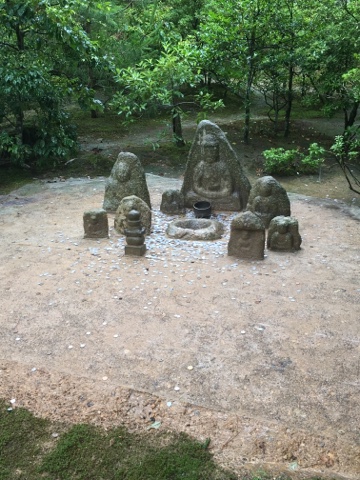Took the JR train to Sago-Arashiyama Station, to pick up the trail from yesterday’s aborted bike ride, without the bikes or rain. Instead it was warm, overcast and very humid. We headed for the Arashiyama Monkey Park Iwatayama. Across the Togetsu-kyo bridge, over Katsura River,
we took steep climb up a hill. It was hard going in the humidity - an electric fan by the path, halfway up the hill, gave us a few minutes relief - but the climb was well worth it as we were able to see, up close, the Japanese Snow Monkeys. These are wild monkeys but they are used to humans so they happily wander past you or frolic around at your feet; a bit unnerving at first but fascinating and fun to watch. You just cannot touch the monkeys or look them in the eye, but there was a caged room that you walk into (the monkeys hang around outside) where you can feed them peanuts and apple pieces.The monkeys know the drill, and expectantly stick an outstretched hand through the wire grill in your general direction.
We wandered along the streets of Arashiyama, doing tourist things – souvenir shopping and watching the passing parade of kimono clad Japanese and athletic rickshaw drivers – on our way to the Arashiyama Bamboo Grove. The path through the Grove was surrounded by thick bamboo stalks and the light had a strange green hue and there was a, seemingly obligatory, shrine (Nonomiya) in the middle of the Grove.
Loads of temples in the Sago-Arashiyama area, including many famous zen gardens but, wanting to cram the most into our last day in Kyoto, we had to give these a miss, walking back to the station to take the train to Nijo.
A short walk from the station, past another interesting shrine on Oike Dori, and we were at the gates of the famous, world heritage, Nijo-ji (Nijo Castle) – home and power-base of the Tokugawa shoguns, when Japan was ruled from Kyoto. Surrounded by a wide moat and imposing stone walls, Nijo-ji is a dominant landmark in northwest Kyoto. Walking through the main palace, it didn’t take long to get the impression that the place was all about shogun swagger! The palace consists of four buildings, joined by interconnecting corridors, that contained expansive halls for the shogun to receive an audience and various ante-rooms for noblemen and councillors to wait to been seen by the shogun, as well as the shogun’s residence. All rooms had gold walls covered in beautiful paintings – depicting tigers, hawk, peacocks, etc - and exquisite hand-carved wooden screens, with the main meeting rooms having the most impressive artwork. The ceilings were also ornate, with exposed beams, ironwork, and painted patterns. (Sadly, no photography allowed inside the palace).
The gardens of Nijo-ji were expansive, and as impressive as the palace, with rocks, ponds and sculptures precisely placed amongst shaped cypress pine, cherry and other trees.
From Nijo it was a short walk to the Kyoto International Manga Museum – much to Ben’s delight! Manga culture has a long history in Japan, and it was interesting to explore this as well as get an understanding of what is distinctive about manga, compared with cartoons originating from other cultures (e.g. the use of action lines, speech bubbles, emotions symbols and other symbols to describe concepts), and also why it is an important part of Japanese culture. While there are some manga artist superstars, it's a pretty tough gig for most artists, and it seems that you haven’t really made it in manga unless you are producing tankobon (serialised manga books). Ben was like a ‘pig in mud’ and disappeared into the museum for over an hour and insisted in buying a tankobon (Fairytale by Hiro Mashima) before we left!
We then walked though the Ninshiki Food Market. As it was now late in the day many of the shopkeepers were closing up, but it was still interesting to see the vast array of foods being sold – many of which we had never seen before and had no idea what they were. While now quite hungry, we just weren’t brave enough to try sashimi on a stick, but enjoyed some piping hot takoyaku from a market stall (good but not nearly as delicious as the takoyaku that Yoji made for us back in Tokyo). At the end of the market was the Ninshiki Tenmangu Shrine (we are in Kyoto, of course) – not sure what god is worshipped here, maybe prosperity….
Across the Kamo River, past street performers, we were now wandering round the Gion district, along the beautiful Furumonzen and through the winding backstreets of Gion, as the sun was setting. We managed to find our way to the infamous Gion Corner, in the hope of seeing some Geishas – alias there we none on the street and we guessed that, being after dark they were now inside entertaining guests….



































































